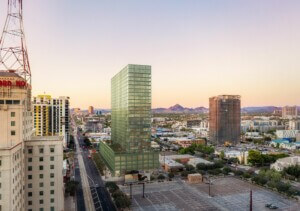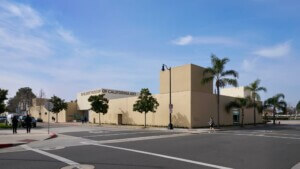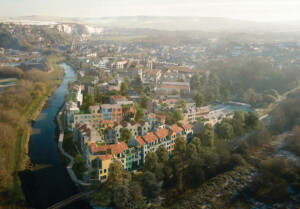From a cedar-clad mixed-use brewery and distillery complex hugging the Columbia River to a cross-laminated timber (CLT) roof-topped tennis pavilion on the grounds of a storied Kansas City athletic club, to a light-frame transitional housing complex in Milwaukee with a gabled roofline and room for 16 families, the winning projects of this year’s U.S. Wood Design Awards, presented by WoodWorks – Wood Products Council, are an appropriately eclectic bunch showcasing wood design at its most daring.
“This year’s award winners epitomize the innovation, resilience, and flexibility required for projects to flourish in a changing world,” said WoodWorks president and CEO, Jennifer Cover, in a statement. “We’re excited to see design and development teams approaching projects holistically, with buildings that respond uniquely to their communities.”
Representing a range of architects (Johnston Marklee, nARCHITECTS, and The Miller Hull Partnership among them) and singular completed projects in a number of geographic locales (the West Coast claims a 38 percent share), the 19 honorees have been bestowed by WoodWorks, a Washington, D.C.-based nonprofit, with either a Regional Excellence Award or a National Award, broken down into nine distinct categories including the coveted Jury’s Choice Award.
The 2021 U.S. Wood Design Awards jury was composed of: Clare Archer, vice president and senior director of Gilbane Building Company, Washington, D.C.; Kate Diamond, civic design director at HDR’s Los Angeles office; Julie Hiromoto, principal and director of integration at the Dallas headquarters of HKS, and John Mitchell, associate partner at Chicago-based Hartshorne Plunkard Architecture.
Noting how “wood continues to demonstrate its value as a nimble and modern building material, ushering in new precedents and challenging the public’s perception of its role in the built world,” Cover added: “A few of this year’s winning projects were completed in 2020 despite obstacles caused by the global pandemic. Through this lens, we are more inspired than ever by the achievements in wood design—from the quality of building systems to the expressiveness of the structures.”
Below you’ll find this year’s winners, projects that incorporate, among other things, glulam beams, nail-laminated timber decking, CLT shear walls, and charred cedar aplenty. Included are basic project details along with a description of each building as provided by WoodWorks along with a juror comment.
National Winners
Multi-Family Wood Design: Timber Lofts | Milwaukee

Structural engineer: Pierce Engineers, INC
Contractor: Catalyst Construction
Building type: Office
Building system: Mass timber
Project description: “Timber Lofts blends old with new, melding the renovation of an historically significant, 1891 industrial loft building with the construction of a sleek new four-story addition. Adjacent to downtown, Milwaukee’s Walker Point neighborhood was already filled with timber-frame buildings, so wood was a compelling choice. The new addition punches into the existing brick building at each floor, creating a continuous interior loop that showcases exposed wood framing in both structures. Luxury apartments in the new building blend high style with an eco-friendly, warm aesthetic featuring exposed glulam columns and beams and CLT ceilings—all highlighted by floor-to-ceiling windows. Timber Lofts was built utilizing Historic Tax Credits, available for the rehabilitation of income-producing buildings that are determined by the National Park Service (NPS) to be ‘certified historic structures,’ which meant that all aspects of the 60-unit project had to be reviewed and approved by the NPS. Timber Lofts was the first building in Milwaukee to be constructed using CLT.”
Juror quote: “I love the adaptive re-use, refurbished portion in particular. They took the best parts of a timber industrial warehouse and transformed it to a really special and unique home.” (Julie Hiromoto)
Wood in Schools: Oregon State University Forest Science Complex | Corvallis, Oregon
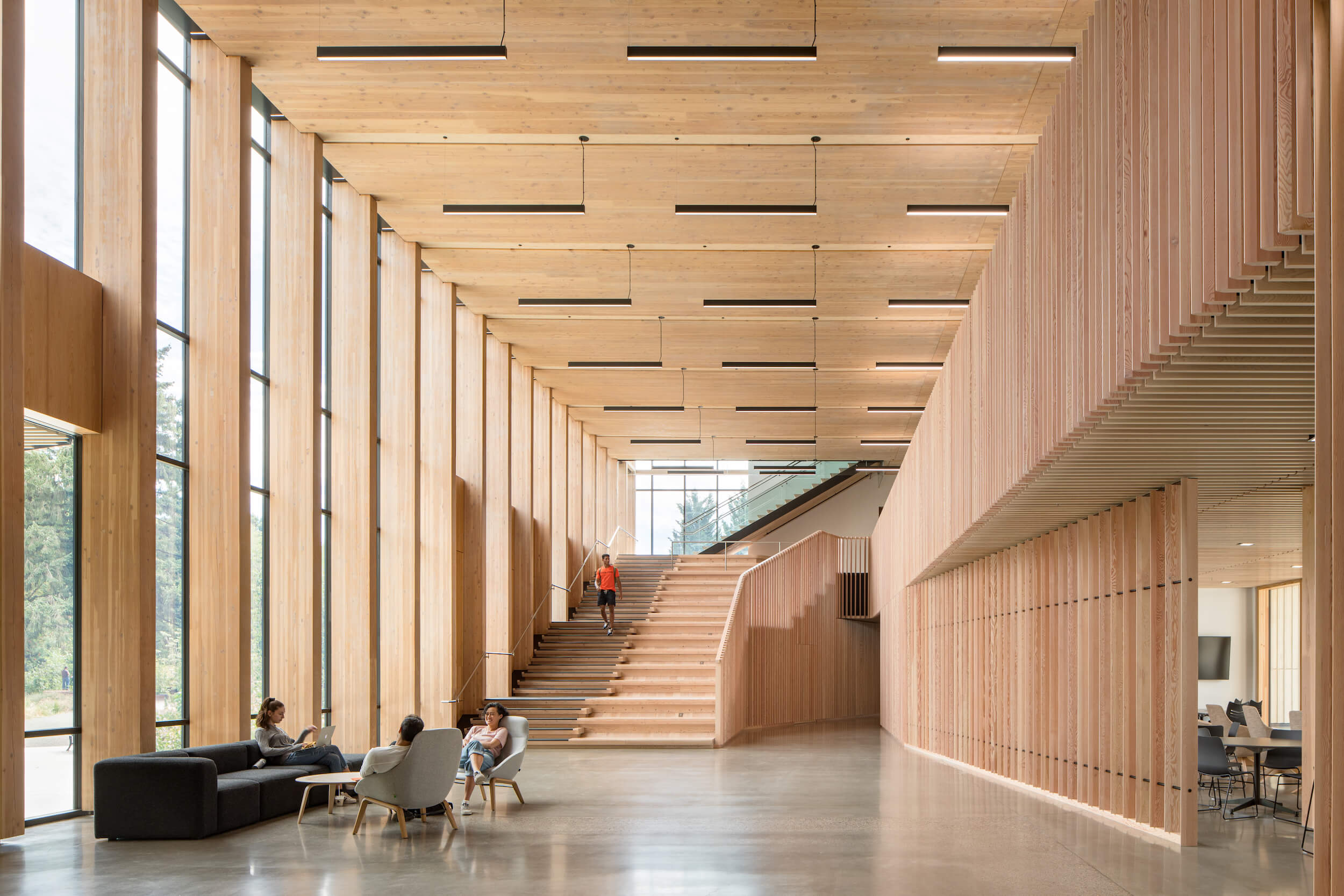
MGA | Michael Green Architecture
Structural engineer: Equilibrium Consulting, a Katerra Company
Contractor: Andersen Construction
Building type: Education
Building System: Mass Timber
Project description: “When a building itself is designed to teach, material choices become even more significant. Two buildings comprise Oregon State University’s new Forest Science Complex. Peavy Hall, which houses classrooms, laboratories, and informal learning spaces, was built using CLT rocking shear walls with CLT floor panels supported by glulam columns and beams. The unique CLT wall system was designed to self-center during a seismic event and allows for components to be selectively replaced, only as needed, after an earthquake. Sensors installed throughout the building continually gather moisture and structural movement data, which will be used for ongoing research into mass timber structural performance. An atrium, located at the heart of Peavy Hall, features CLT-concrete composite floor panels and towering glulam columns topped by mass plywood panels (MPP)—the first commercial use of this innovative wood product. Nearby, the A.A. ‘Red’ Emmerson Advanced Wood Products Laboratory provides space for wood products manufacturing and structural testing. This building is framed with a unique glulam and MPP system designed to meet both high seismic requirements and the long spans needed for the sizeable space.”
Juror quote: “In addition to its use of an innovative wood structural system to mitigate seismic impact, I appreciated the ‘building as a teacher’ concept that integrated into the design – embedding sensors to gather long-term data that will advance wood design in the future. Brilliant.” (Clare Archer)
Commercial Wood Design – Low-Rise: Cakebread Cellars | Rutherford, California

Structural engineer: Kenneth Campbell Structural Engineer
Contractor: Wright Contracting
Building type: Commercial low-rise
Building system: Mass timber + light-frame
Project description: “When Cakebread Cellars expanded their renowned Napa Valley winery, adding a new visitor’s center with nine new tasting rooms, office space, and a new production area, they chose a stunning wood-centric design to celebrate the winery’s rich history. The design team made innovative use of heavy timber and light wood framing in their new hospitality and production areas, creating a modern tasting experience for guests and seamlessly integrating the new facilities with existing buildings on the property. Glulam beams frame the grand entry, setting the stage with a stunning yet peaceful and serene atmosphere. Inside, custom wood light fixtures provide a natural, dramatic focal point, highlighting the wood walls and ceiling. Wood also features prominently in the tasting rooms, creating an atmosphere that is both sophisticated and welcoming. Finally, glulam beams and wood decking frame the expansive production area, so the view into the work area matches the rest of the winery’s luxe aesthetic.”
Juror quote: “This project highlights a lot of different applications of wood in a detailed structure; there are a lot of different aspects to it.” (John Mitchell)
Commercial Wood Design – Mid-Rise: Outpost | Hood River, Oregon

Structural engineer: Valar Consulting Engineers
Contractor: Celio Contracting Inc.
Building type: Commercial low-rise + office
Building system: Mass timber + light-frame
Project description: “Functioning as one large structure, each of the two three-story buildings that form Outpost are aligned within the exterior envelope but separated to create a central, shared area with terraces, an outdoor fireplace and an expansive, partially covered pavilion. Locally sourced glulam beams are left exposed throughout, complemented with infill walls and pathways covered in Douglas fir decking. Outside, both buildings feature naturally finished cedar on the ground floor and charred cedar cladding above. The visual distinction between upper and lower floors reveals the unique functional separation inside the building. Outpost’s ground floor houses light industrial activities—a brewery, distillery and maker spaces—while the upper floors offer retail, office and recreation spaces. Moving traditional street-level retail to the second floor means that shoppers and restaurant goers have views of the Columbia River, Mt. Adams and Mt. Hood, while first-floor industrial tenants have street access and double-height spaces. Exposed wood ceilings and wall surfaces help absorb and reduce noise from the industrial uses at the ground level, protecting the restaurant and office spaces above.”
Juror quote: “Interesting contrast of colors, texture, and a mix of simple masses define the project. There’s also a restraint to it that I appreciate.” (Julie Hiromoto)
Institutional Wood Design: The Discovery Center | Philadelphia

Structural engineer: CVM
Contractor: INTECH Construction, Inc.
Building type: Civic/recreational
Building system: Light-frame
Project description: “A simple light wood-frame design provided an economic building solution for this urban bird sanctuary and leadership development center. Simple form and use of wood allow The Discovery Center to fade into its natural environment. Two wings of the building, each with platform-framed walls and prefabricated roof trusses, are joined by a connecting roof. The east wing includes exhibition space, meeting rooms, administrative space, and a storage area, while the west wing includes a large multi-functional event space for meetings, workshops, and gatherings. Plated wood roof trusses have been left exposed in all primary interior spaces, providing visual warmth and maximizing volume. The building is flanked by a nearly 500-foot-long charred cedar façade and site wall that incorporates bird ‘nesting shelves.’ The light-colored, cedar-clad entry portal welcomes visitors while the dark charred cedar creates a neutral backdrop to the seasonal colors of the landscape. In keeping with the Center’s community focus, exterior wall panels were flame charred, shop fabricated, and installed by a non-profit construction training program that introduces urban youth to the carpentry trades.”
Juror quote: “There is a sense of delight and discovery in this aptly named project. I think that’s so important in the built environment: sparking the curiosity and active exploration of the building draws attention to the materiality, the structural innovations and of the design elements that make this a successful project.” (Julie Hiromoto)
Durable & Adaptable Wood Structures: Trefethen Historic Winery | Napa, California
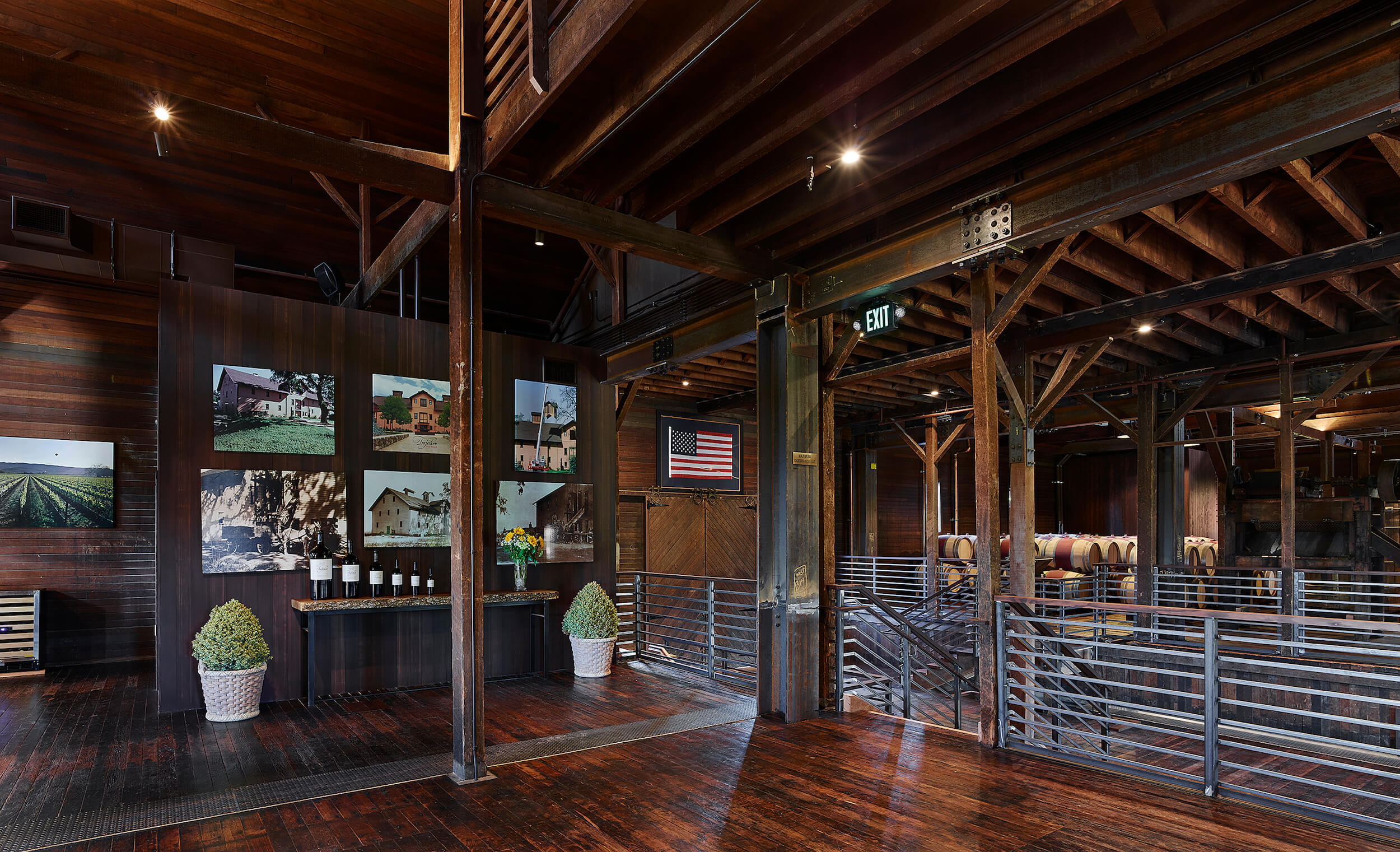
Taylor Lombardo Architects with Preservation Architecture
Structural engineer: ZFA Structural Engineers
Contractor: Facility Development Company
Building type: Commercial low-rise
Building system: Timber-frame + light-frame
Project description: “A 2014 earthquake left the historic Trefethen winery in a precarious tilt when the second and third story of the three-story structure shifted nearly four feet. Because it was built in 1886 and listed on the National Register of Historic Places, the Trefethen family decided to undertake an extensive restoration. Crews removed and repaired the exterior redwood siding, then strengthened and straightened the internal wood structure by adding two bolted-connection steel moment frames, aligned with the original timber posts. Where possible, they repaired damaged wood framing members by injecting color-matched wood epoxy. They also installed new connectors between existing beams, posts, and foundations, and added bolted steel side plates at floor beams for additional strength. By doing all this, they were able to preserve the majestic, vaulted spaces in the tasting room and barrel storage area, while still showcasing the original timber construction. Next, they installed new exterior shear walls and re-clad the building using the original redwood siding. As final tribute, the Trefethen family left a single ‘Remembrance Post’ in its deflected state to illustrate the magnitude of the earthquake withstood by the structure.”
Juror quote: “The story of this project is terrific—and the end result still looks very cool. You’d never know that at one point this was a parallelogram-shaped building.” (John Mitchell)
Green Building with Wood: The Kendeda Building for Innovative Sustainable Design | Atlanta

The Miller Hull Partnership in collaboration with Lord Aeck Sargent, a Katerra Company
Structural engineer: Uzun + Case
Contractor: Skanska USA
Building type: Education
Building system: Mass timber
Project description: “Innovative is a key descriptor for this highly sustainable building, the first timber structure built at Georgia Tech since the 1880s. The building houses lab space, classrooms and a lecture hall, all surrounding a two-level atrium. The design team chose mass timber for its environmental benefits and took full advantage of the inspiration and learning opportunities by putting the wood structure on
display. The Kendeda Building uses a diverse array of building materials, including nail-laminated timber (NLT) decking, glulam beams and columns, and salvaged wood for stair treads. Hybrid glulam and steel queen post trusses span the large spaces. Gravity and lateral elements are left exposed to give students a visual register of the structural forces at work. Exterior wood siding was harvested from recovered cypress sinker logs to further the sustainability message. And a steel porch canopy captures enough rainwater and solar energy to meet the site’s water and energy demands. The project is pursuing Living Building Challenge certification.”
Juror quote: “This is truly a gold-standard for integrated sustainable design that uses mass timber to reduce the embodied carbon footprint and to create a warm and beautiful learning environment.” (Kate Diamond)
Beauty of Wood: Karsh Alumni and Visitors Center at Duke University | Durham, North Carolina

Centerbrook Architects and Planners
Structural engineer: LHC Structural Engineers
Contractor: LeChase Construction
Building type: Education
Building system: Mass timber + light-frame
Project description: “Duke University’s new alumni and visitors center is the first structure people see as they arrive on campus, and administrators wanted it to reflect the institution’s history and character. They wanted a design that aligns with Duke’s description as a ‘University in the Forest,’ and signifies their commitment to sustainability and environmental stewardship. The four-building complex includes an event center with large lobby, a meeting pavilion, the historic Forlines House with meeting rooms and offices, and a new office building for the Alumni Association. The buildings are organized around a central court and outdoor arcade. Wood was used inside and out as both structure and finish to enhance the connection between the built and natural environment. The two public buildings feature vaulted ceilings formed by complex southern pine glulam arches, which allow space for clerestory daylighting. Wood ceiling panels are spaced for acoustic control. Floors are red oak, and the wood paneling, desks, and cabinetry are made from white oak harvested from Duke’s own forests. The arcade was built using cypress glulam, selected for durability, and constructed to match the soaring glulam arches inside.”
Juror quote: “One of the challenges of designing a new building on a campus with a strong classical language is how to both contribute to the overall coherence of place and still be of our time. This project is a perfect example of how to do this and wood plays an essential part in making it beautiful.” (Kate Diamond)
Wood in Government Buildings: Jones Beach Energy & Nature Center | Wantagh, New York

Structural engineer: Silman Structural Engineering
Contractor: Scalamandre Construction
Building type: Civic/recreational
Building system: Mass timber + light-frame
Project description: “Surrounded by land reclaimed from a demolished concrete parking lot, the 330-foot-long Jones Beach Energy and Nature Center houses offices and classrooms, while a continuous exhibition space flows from gallery to gallery, spilling out onto a shaded canopy and amphitheater. The silhouette of the mass timber roof structure, framed with glulam beams and wood decking, evokes a series of waves, reflecting the Center’s mission of environmental education. Wood was the perfect choice for this building because it created a light structure that could be built on the foundations of the 1960s-era bathhouse that had occupied the site. Timber piles form a pier-like deck surrounding the Center, addressing the constraints of the building’s location on a flood plain and connecting it to the coastal context. The natural patina of the cedar cladding will fade to silver, blending with its natural setting. Inside, designers used the warmth of wood to welcome visitors and create a comfortable atmosphere that promotes learning. An interactive model and video of the net-zero building greets visitors as they enter the lobby, explaining how the building generates as much energy as it consumes from its 260 rooftop solar panels.”
Juror quote: “I love that it’s a net-zero-energy project, and the story about the landscape being reclaimed from almost ten acres of concrete surface parking lot. The building nestles nicely in the landscape and I love how the shadow patterns of the wood slats juxtapose with the vertical facade.” (Julie Hiromoto)
Jury’s Choice: Freedom House | Green Bay, Wisconsin

Structural engineer: RA Smith, Inc.
Contractor: Immel Construction
Building type: Institutional
Building system: Light-frame
Project description: “The Freedom House expansion project demonstrates how wood can be used to create simple, affordable yet beautiful housing. Freedom House Ministries provides transitional housing and programming to help families who need temporary living assistance. The organization needed a new facility to support two distinct occupancies: residential for transitional housing, and business for administrative staff and programming services. A challenging site prompted the design team to develop a bifurcated plan, separating the two occupancies but linking them with a glazed bridge. The structure with five gabled roof forms provides space to house up to 16 families, each in private rooms with dedicated bathrooms. The larger administrative wing, where programming spaces are located, is built into the adjacent hillside. Use of natural cedar cladding unifies the two buildings and speaks to the goal of providing simple, sustainable living with a familiar, warm and welcoming aesthetic. Light wood framing was used for all primary structural elements, including walls, roof, and floors. Wood’s ready availability fit the tight construction timeline, allowing the shelter to open before winter arrived.”
Juror quote: “I love the mission of this project and the way they used wood to create an atmosphere of home.” (Clare Archer)
Regional Excellence Winners
1040 W. Fulton | Chicago
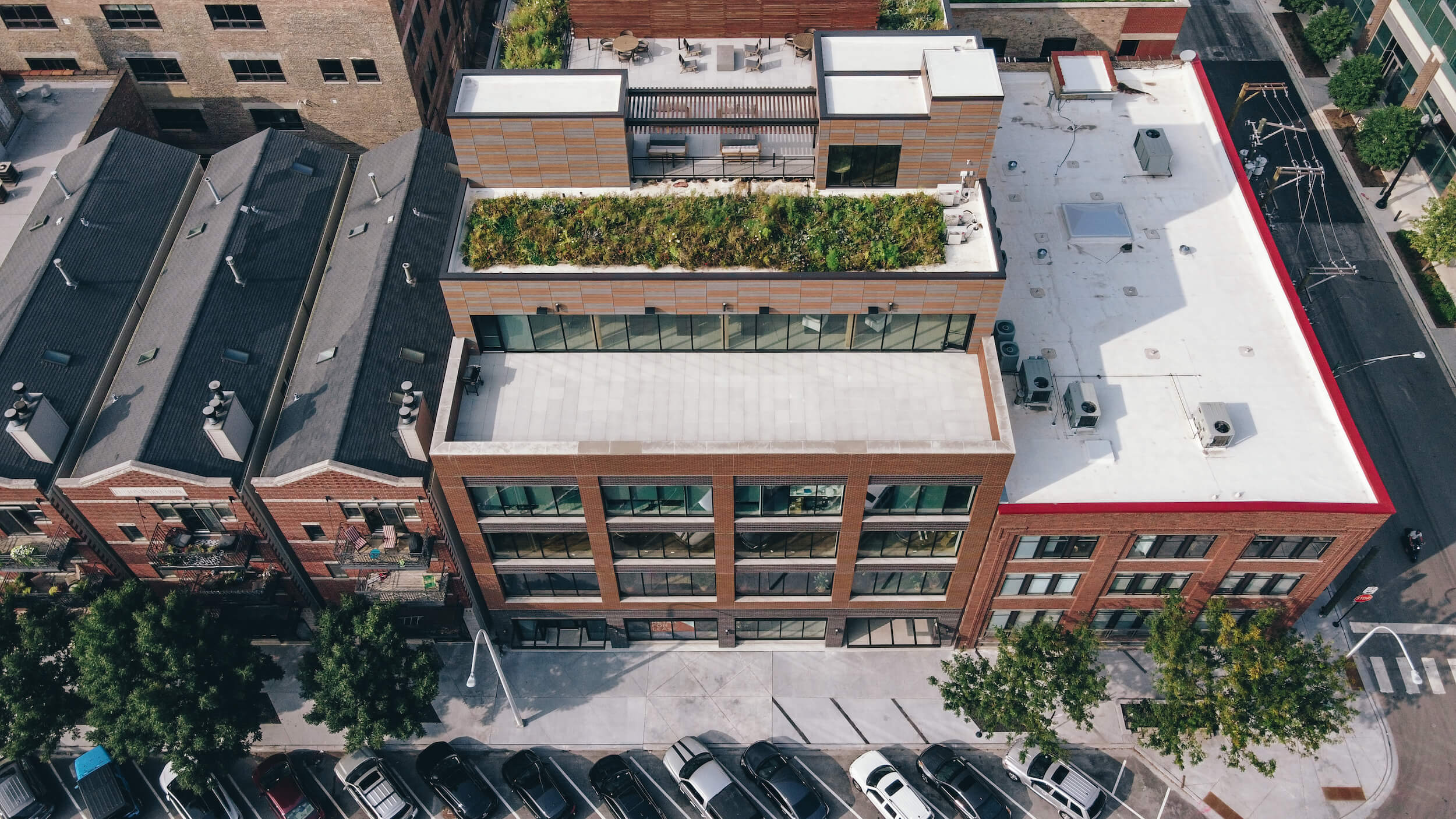
Hartshorne Plunkard Architecture
Structural engineer: IMEG Corporation
Contractor: Summit Design + Build, LLC
Building type: Office
Building system: Mass timber
Project description: “Located in a neighborhood filled with decades-old timber lofts and former meatpacking warehouses, 1040 W. Fulton expanded the area’s rich heritage when it became one of the first multi-story timber office buildings to be constructed in Chicago in decades. Heavy timber was an obvious choice for the five-story building since exposed wood spaces were not only expected but sought after by tenants seeking leases in the historic district. At the time 1040 W. Fulton was built, the Chicago Building Code allowed a prescriptive path for mass timber construction but had no specific allowances for glulam use. So, the team worked closely with building officials and as a result, the City of Chicago updated its building code to allow for glulam construction, setting the stage for the future. 1040 W. Fulton’s structure is a mix of steel, concrete and heavy timber with exterior walls comprised of steel columns and beams that support the brick cladding. The interior structure includes glulam columns, girders, and beams with tongue-and-groove wood decking, left exposed to differentiate the iconic address.”
Juror quote: “I like how the team integrated wood construction, particularly its glulam members to ‘speak’ to the historic fabric of its Fulton Market neighborhood, but in a fresh modern context.” (Clare Archer)
UCLA Margo Leavin Graduate Art Studios | Culver City, California
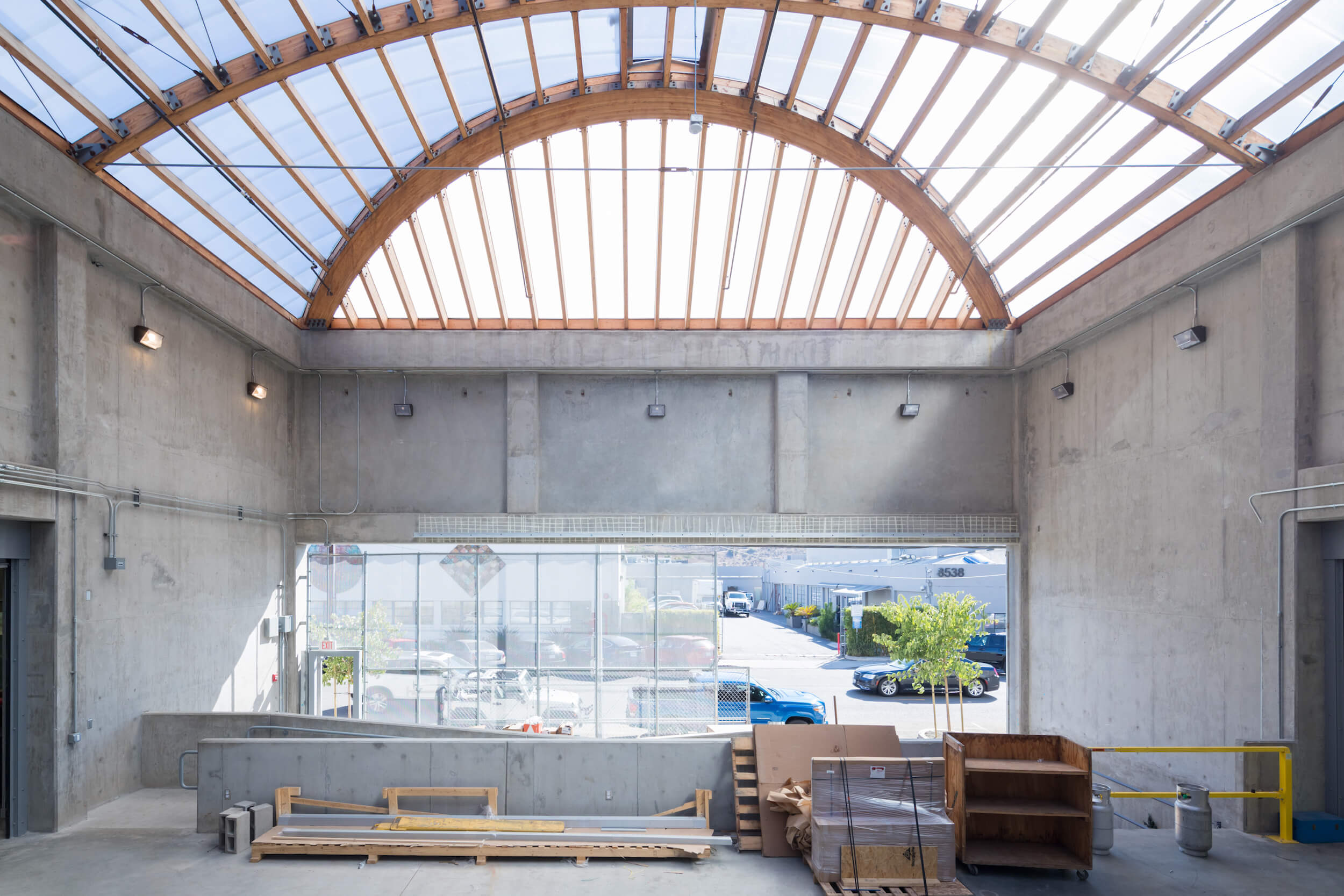
Structural engineer: Simpson Gumpertz & Heger
Contractor: Abbott Construction
Building type: Education
Building system: Mass timber + light-frame
Project description: “UCLA needed to expand studio space for their Master of Fine Arts program, housed in a former wallpaper factory, but they wanted to retain the open, industrial spirit of the existing building. So, they renovated the original warehouse and built a new L-shaped addition surrounding it, adding artist studios, lab spaces, a gallery, classrooms, and covered outdoor space. They restored the wood bowstring trusses in the original warehouse and then used pillowed concrete tilt-up walls and a curved wood vault roof for the new structure. Glulam was chosen to extend the character of the original wood trusses into the new addition; the unique vaulted configuration was adapted to reduce double curvature while maintaining large clear spans. The vaulted glulam roof structure is left exposed to space below; they even left the wood wall framing visible at the tops of the individual artist studio walls to provide visual tie-in. High ceilings, expansive spaces and natural light support the creative endeavors within, which include ceramics, painting and drawing, photography, sculpture, and more. The project achieved LEED Gold certification.”
Juror quote: “The use of wood and its juxtaposition in relationship to the heavier tilt-up concrete is kind of amazing. It’s structural, but it’s also the ultimate jewelry of this project.” (Kate Diamond)
Tennis Pavilion | Kansas City, Missouri

Structural engineer: SMA Engineering
Contractor: Centric Projects
Building type: Civic/recreation
Building system: Mass timber
Project description: “This Tennis Pavilion used CLT roof and walls for an unexpected but aesthetically warm and structurally progressive building solution. The Pavilion, located in the heart of an historic athletic club, anchors the otherwise unstructured tennis court layout. Clean lines of the sloped CLT roof extend seamlessly from inside out, inviting natural light in while forming shaded viewing platforms outside that connect viewers to players in the surrounding courts. The scissoring roof form reduces the building’s energy usage by minimizing thermal breaks and allowing for improved insulation and natural ventilation. Inviting aesthetics of the wood panels provide material warmth for the Pavilion, which houses a pro shop, gathering areas, indoor and outdoor seating, food and beverage area, and locker rooms. Large panel sizes and the slender roof profile create a contemporary interpretation of the existing clubhouse veranda, while use of natural wood stays consistent with the progressive and environmentally conscious nature of the club.”
Juror quote: “This project has a lot of movement and really nice lines, but it doesn’t compete with the very rigid kind of geometry of the tennis court. What a delightful project.” (Julie Hiromoto)
Princeton University Laboratory for Embodied Computation | Princeton, New Jersey

The Living (design architect) and NK Architects (architect of record)
Structural engineer: Buro Happold Consulting Engineers
Contractor: Epic Construction
Building type: Education
Building system: Mass timber
Project description: “This small but beautiful structure stands out for its detailing and use of sustainable materials, serving to inspire those who use it for architectural research. This facility is used for interdisciplinary educational collaboration on fabrication, robotics and sensors—studies where computers meet the physical world to become ‘embodied computation.’ With glazed doors that fully open at one end, the large double-height warehouse-like building allows for flexible reconfiguration of classroom, workshop, testing, and research space. Since low carbon emissions is a key focus for the work that goes on within, wood was a natural choice. Inside, a five-ton gantry crane rides along rails sitting atop the glulam post and beam structure. Scaffolding boards salvaged from New York City construction sites were sand-blasted and then used as exterior cladding, giving the building a uniquely beautiful, weathered façade. The custom-made CNC sand-blasting equipment was designed to use algorithms that detect wood knots. Princeton researchers are working to determine if geometries of the grain change in the blasted wood will impact the thermal performance of the material.”
Juror quote: “Performing beautifully—not only does this project delight the senses; it pushes the envelope on wood as a structural replacement for steel and many other firsts.” (Julie Hiromoto)
Platte Fifteen | Denver

Structural engineer: KL&A Engineers & Builders
Contractor: Adolfson & Peterson Construction
Owner/developer: Crescent Real Estate, LLC
Building type: Office
Building system: Mass timber
Project description: “This unique office building, the first in Denver to use CLT, features a highly efficient floor plan, floor-to-ceiling windows and a rooftop deck providing unobstructed views of downtown Denver and the Rocky Mountains. Glulam beams and columns and CLT floor and roof panels are left exposed, visible from both outside and in, to create an iconic business address for this spec office building. A desire to use sustainable building materials drove the decision to use wood, and the design team created an elegant interior to take full advantage of the exposed structure. They carefully coordinated MEP locations to preserve the clean look and feel of the wood, which also increased construction efficiency. The zero-lot-line location required careful collaboration with material delivery and installation; precise prefabrication of the glulam and CLT panels ensured a speedy, smooth erection process. Because this was Denver’s first CLT building project, the design and construction team gave area students, building officials, fire departments, and surety partners tours and opportunities to learn about the material, smoothing the way for future mass timber projects.”
Juror quote: “I love seeing a spec office developer working in mass timber and what it says about the shift toward sustainability as a design driver.” (Kate Diamond)
Cedar Speedster | Seattle

Structural engineer: DCI Engineers
Contractor: Turner Construction Company
Building type: Office
Building system: Mass timber
Project description: “Cedar Speedster pays homage to the neighborhood’s wood-centric history with heavy timber construction, exposed wood car deck ceilings, and exterior cedar cladding. Housing the offices of a leading outdoor retailer, the exposed wood structure reflects the company’s commitment to authentic outdoor lifestyle and experiences. Two restaurants and a brewery taproom occupy the ground floor, which also features a large outdoor terrace. The expressive wood structure and cedar-clad exterior are accented by weathering steel, for a natural vibe that fits the neighborhood perfectly. Innovative connection details highlight the interaction between the wood structure and other materials. Glulam columns run continuously from the ground floor to the roof to reduce shrinkage and speed construction. Glulam girders were dropped below the bottom of the car decking to allow mechanical and fire systems to run over the beams, not below, and allow the beauty of the wood to remain visible. The Douglas fir decking was installed unfinished, leaving the natural wood free to create an environment designed to boost employee well-being and productivity.”
Juror quote: “Interesting and compelling details. I like that wood is highlighted as the structure and cladding, and that wood’s interaction with other materials is also highlighted. That’s an important aspect and can be really beautiful and interesting.” (John Mitchell)
Biomass Boiler Building | Quincy, California

Structural engineer: Holmes Structures
Contractor: Houston Construction
Building type: Industrial
Building system: Mass timber
Project description: “Wood is not a typical building material choice for industrial structures, making the attractiveness of the Biomass Boiler Building even more noteworthy. This small, 33-foot-wide single-span facility houses a community-scale biomass boiler with a small-scale power generator. The innovative system uses organic waste material to generate heat and power for the adjacent Plumas County Health and Human Services Department. As might be expected, Plumas County had originally envisioned a traditional prefabricated metal building, but then turned to wood to underscore their commitment to renewable materials and sustainable forestry. This mass timber structure uses CLT roof and wall panels acting as both the vertical and lateral force-resisting systems, making this the first application of CLT shear walls in California. The County’s decision to use a mass timber system also provided benefits in terms of speedy installation and small crew size requirements. From concept development to substantial completion, the project was completed in less than a year.”
Juror quote: “It tells a story that wood is applicable across many spectrums. It’s not something that shouted out for wood construction, but the wood makes sense.” (Clare Archer)
Andy Quattlebaum Outdoor Education Center at Clemson University | Seneca, South Carolina

Structural engineer: Britt, Peters and Associates Inc.
Contractor: Sherman Construction
Building type: Education
Building system: Mass timber
Project description: “Wood and steel worked together in the design of this lakefront recreation complex for Clemson University students. The center features social space, rooms for activities such as yoga, rowing, and aerobics, as well as traditional classrooms. Students can also check out camping, biking, and boating gear. As Clemson’s first mass timber facility, the Center features CLT floors, roof, and shear walls, supported by glulam beams and steel columns. The southern yellow pine CLT panels were manufactured in nearby Dothan. Designers left the structural wood members exposed, eliminating the need for almost all ceiling finishes, which helped reduce construction material and labor costs. The expansive roof’s large overhangs provide shade for terraces where students can relax outside. Visual warmth of the exposed wood speaks to the function of the facility, emphasizing its role in promoting fitness and wellness for Clemson students. While the Center was designed primarily to promote student wellness, its use of wood also reflects the positive connection between sustainability, concern for the environment and a love of outdoor activities.”
Juror quote: “I like the details of this project and how the wood and steel work together.” (John Mitchell)
Church of the Incarnation Chapel Addition | Dallas
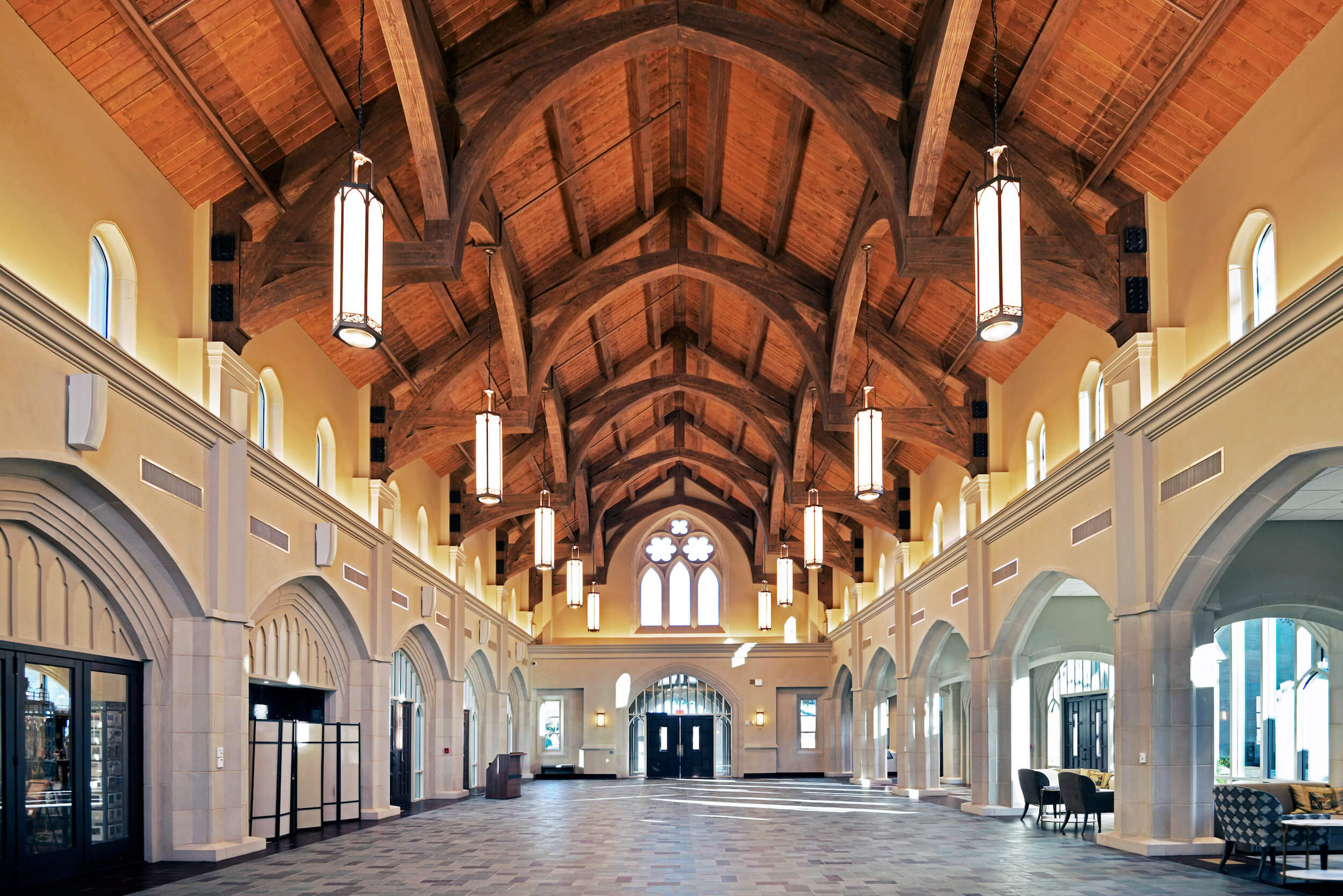
Structural engineer: Datum Engineering, Inc.
Contractor: Lee Lewis Construction
Building type: Institutional
Building system: Mass timber
Project description: “This project is a beautiful example of how sculptural wood was used to distinguish a modern addition to this prominent Dallas church. The expansion project consisted of a new Parish Hall, a new 300-seat chapel and a prayer room. The Gothic-style chapel and three-story parish hall both feature heavy yet intricate wood roof trusses, designed to create a visually inspiring focal point in each. The chapel features a glulam hammer-beam truss ceiling that soars over the worship space. Glulam beams over the parish hall are similar in size and shape, arched to frame the beautiful windows. The glulam trusses have concealed bolted connections, leaving visual focus on the wood itself. Tongue-and-groove wood decking and wood purlins span the glulam trusses in both spaces, leaving a warm yet elegant view above.”
Juror quote: “The arches are beautiful and the focal point. It’s nice to see a modern church expansion with such an elegant application of wood.” (John Mitchell)








